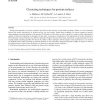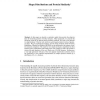129 search results - page 11 / 26 » Multipolar representation of protein structure |
ISMB
1993
13 years 9 months ago
1993
Weintroduce a parallel approach, "DT-SELECT," for selecting features used by inductive learning algorithms to predict protein secondary structure. DT-SELECTis able to ra...
PR
2006
13 years 7 months ago
2006
Though most approaches to protein comparison are based on their structure, several studies produced evidence of a strict correlation between the surface characteristics of protein...
BMCBI
2007
13 years 7 months ago
2007
Background: Predicting a protein’s structural class from its amino acid sequence is a fundamental problem in computational biology. Much recent work has focused on developing ne...
GCB
2006
Springer
13 years 11 months ago
2006
Springer
: In this paper we describe a similarity model that provides the objective basis for clustering proteins of similar structure. More specifically, we consider the following variant ...
BMCBI
2004
13 years 7 months ago
2004
Background: Hidden Markov Models (HMMs) have proven very useful in computational biology for such applications as sequence pattern matching, gene-finding, and structure prediction...


